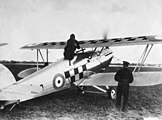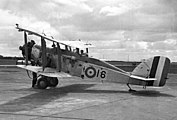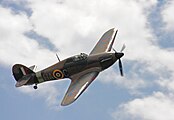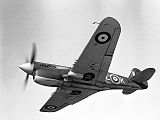
The Desert Air Force (DAF), also known chronologically as Air Headquarters Western Desert, Air Headquarters Libya, the Western Desert Air Force, and the First Tactical Air Force (1TAF), was an Allied tactical air force created from No. 204 Group RAF under RAF Middle East Command in North Africa in 1941 to provide close air support to the British Eighth Army against Axis forces. Throughout the Second World War, the DAF was made up of squadrons from the Royal Air Force (RAF), the South African Air Force (SAAF), the Royal Australian Air Force (RAAF), the United States Army Air Forces (USAAF) and other Allied air forces.
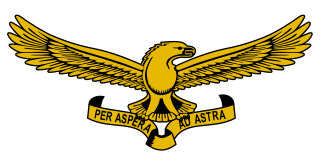
The South African Air Force (SAAF) is the air warfare branch of South African National Defence Force, with its headquarters in Pretoria. The South African Air Force was established on 1 February 1920. The Air Force saw service in World War II and the Korean War. From 1966, the SAAF was involved in providing infantry support in the low-intensity Border War in Angola, South-West Africa and Rhodesia. As the war progressed, the intensity of air operations increased, until in the late 1980s when the SAAF were compelled to fly fighter missions against Angolan aircraft in order to maintain tactical air superiority. On conclusion of the Border War in 1990, aircraft numbers were severely reduced due to economic pressures as well as the cessation of hostilities with neighbouring states.

2 Squadron is a squadron in the South African Air Force which was formed in 1940. The squadron has a long history, having been involved in every single combat action in which the SAAF has taken part. During the Second World War it made a name for itself in the battles for East Africa, before distinguishing itself in North Africa as part of the Desert Air Force, and later in Italy.

41 Squadron is a light transport squadron of the South African Air Force. It was formed in 1940, it is currently based at AFB Waterkloof.

24 Squadron SAAF is a disbanded squadron of the South African Air Force. Its last role was as an attack aircraft squadron. The squadron was first formed during World War II on 5 March 1941 by renumbering 14 Squadron SAAF in Egypt. It later carried out bombing operations in Kenya and North Africa, before taking part in the Italian campaign before disbanding in late 1945 at the conclusion of hostilities. The squadron was later re-raised and operated jet aircraft in an attack role during the Border War. It was finally disbanded in early 1991.

1 Squadron SAAF was an air force squadron of the South African Air Force and was formed at Air Force Station Swartkop in February 1920, equipped with De Havilland DH.9's part of the Imperial Gift donation to South Africa by Britain. On 31 August 1939 the squadron was re-designated as 1 Bomber/Fighter Squadron and this was then changed to 11 (Bomber) Squadron in December 1939. The squadron was resurrected in February 1940 by the renumbering of 6 Squadron, equipped with four Hurricane Mk 1's and six Furies.

40 Squadron SAAF existed as a combat unit from early 1940 through to late 1945. It served in the East African Campaign, Western Desert, Tunisia, and Italy, reaching Austria by the end of World War II. The squadron's motto in those years was Amethlo e Impi – "the eyes of the army".
No. 225 Squadron RAF is a former Royal Air Force squadron.

3 Squadron SAAF was a squadron of the South African Air Force. It was formed in January 1939 at Air Force Base Waterkloof and was equipped with Hawker Hartbees I and Hurricane Mk II aircraft. The squadron was moved to Port Elizabeth in September 1939 after which it was disbanded. It was again reformed at Waterkloof on 9 September 1940 equipped with Hurricane Mk 1s.
No. 185 Squadron RAF was a Royal Air Force Squadron formed in World War I and reformed as a bomber and fighter unit in World War II. It then reformed in Malta in the post war period as a jet fighter squadron.

5 Squadron SAAF was a South African Air Force Fighter / Fighter-Bomber squadron during World War II. It was disbanded at the end of the war and was re-commissioned in 1950. It remained active until 2 October 1992, when it was disbanded; its Atlas Cheetah E aircraft were also decommissioned.

6 Squadron was a South African Air Force unit first formed just before World War II. It was disbanded and re-created a number of times, until finally disbanded in October 1990.

7 Squadron was a unit of the South African Air Force which served in the Second World War as well as in South Africa between 1951 and 1992. During the war, the squadron was used as a fighter squadron deployed to the Western Desert as well as in the Aegean, Italy and Ceylon. The squadron was inactive from the end of the war until 1951 when it re-activated as a citizen force training squadron, a role it retained during two periods of active service until 1992, when it was disbanded for the last time.

12 Squadron was a South African Air Force squadron that served in the Second World War in East Africa and the Western Desert as a medium bomber squadron. After the war, the squadron was used in various roles, including that of a helicopter squadron until 1963, when it was equipped with English Electric Canberra light bombers, remaining a light bomber and reconnaissance squadron until disbanded in 1990.

10 Squadron was a squadron of the South African Air Force. It was formed as a fighter bomber unit on 1 April 1939 and was deployed in a coastal defence role as part of Coastal Command SAAF until 1943. It was disbanded after the threat of Japanese naval actions off the South African coast had waned. It was re-activated as a fighter squadron on 25 May 1944 and deployed to the Middle East where the squadron saw service in Syria, Libya and the Aegean and was disbanded at the end of the war in Italy.

11 Squadron was a World War II squadron of the South African Air Force. It was created in South Africa in 1939 and served in East Africa until 1941 as an army cooperation and reconnaissance squadron. It was re-formed in 1944 as a fighter bomber squadron and served in Italy until 1945 when it returned to Egypt and was disbanded on conclusion of the war on 30 October 1945. It was re-activated in 1974, flying Cessna 185s as an army liaison squadron until 1991 when it disbanded for the final time.
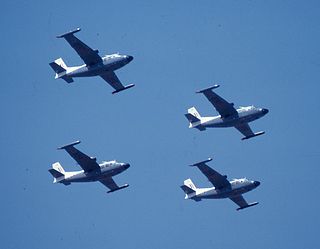
27 Squadron was established as a World War II maritime patrol squadron of the South African Air Force. It was disbanded after the war and resurrected in the same role from 1951 to 1958. Its final period of service was from 1962 to 1990 when it was finally disbanded when its Piaggio Albatross aircraft were de-commissioned.
The History of the South African Air Force spans the First World War, Rand Rebellion of 1922, the Second World War, the Korean War, the South African Border War, and varied peacekeeping operations since 1994. Its battle honours include German South West Africa 1914–15, German East Africa 1915–1918, East Africa: 1939–1941, Middle East: 1941–43, Madagascar 1942, Italy 1943–1945, the Balkans 1943–1945, and Korea 1950–1953.

16 Squadron SAAF is an attack helicopter squadron of the South African Air Force (SAAF). It was originally formed in World War II as a maritime patrol squadron, however, over the course of the war it was disbanded and reformed a number of times, operating a number of different types of aircraft. It was finally disbanded in June 1945 and was not re-raised until 1968 as a helicopter squadron. In the late 1980s the squadron took part in the conflict in Angola before being disbanded again in 1990. It was raised once more in 1999 and it is currently operating the Rooivalk attack helicopter.

No. 8 Wing SAAF was a South African Air Force commanded formation during World War II that served in Italy, the Balkans and the Mediterranean Theatre. It was formed on 25 July 1944 and consisted of Royal Air Force and South African Air Force squadrons under South African command. MAAF on 13 June 1944 asked the SAAF to reman immediately a new defensive fighter wing HQ to embrace No. 3 Squadron, No. 11 Squadron and No. 41 Squadron. By 22 June the request had been approved. Col "Rosy" du Toit opened the new office for the Wing in the SAAF Headquarters building in Bari on 16 July 1944. HQ 8 Wing would also take control of No. 87 Squadron RAF and No. 185 Squadron RAF Lt-Col D.D. "Snowy" Moodie was appointed Sweep Leader of the new Wing. On 25 July 8 Wing came under administrative control of Desert Air Force. 8 Wing Headquarters moved from Foiano to Borghetto on 10 September 1944. where the two RAF squadrons joined the Wing, together with RAF No. 53 RSU. By the end of September, a it became clear that the end of the war was not at hand, the SAAF had two fighter-bomber Wing operating in Europe simultaneously for the first time.



